Entrelac [Knitting Stitch]
The technique for Week 12 of the Summer Stitch Sampler Knit Along is Entrelac.
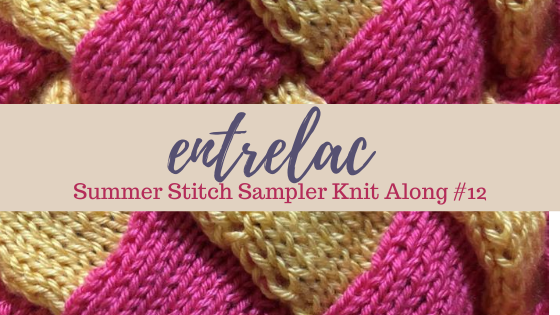
Download PDF | Add to Ravelry Queue | Pin on Pinterest
Thank you for joining us! Instructions are provided for this section of the afghan only. The Summer Stitch Sampler Knit Along overview information can be found here.
The Facebook group for the SSS KAL can be found here.
Section 12 – Entrelac
Directions for small (36″ x 40″) and large (48″ x 65″) afghans are provided as S (L).
Materials
Materials are provided for this section of the afghan only. For a comprehensive list of materials needed, return to the Summer Stitch Sampler Knit Along overview.
Yarn:
100 (215) yards of worsted weight yarn
Pictured: Caron Simply Soft in Sunshine and Watermelon (Colors B and C)
Abbreviations
k – knit
kfb – knit 1 into front and back of a stitch; single knit increase
k2tog – knit 2 stitches together; single right-leaning decrease
LHN – left hand needle
p – purl
psso – pass slipped stitch over
p2tog – purl 2 stitches together; single decrease
sl – slip
ssk – slip 2 stitches knitwise, knit these 2 stitches together through back loops; single left-leaning decrease
st(s) – stitch(es)
Pattern
You will need yarn in Colors B and C for this section. It can also be worked in one color.
All sections of the pattern are worked back and forth from the bottom up.
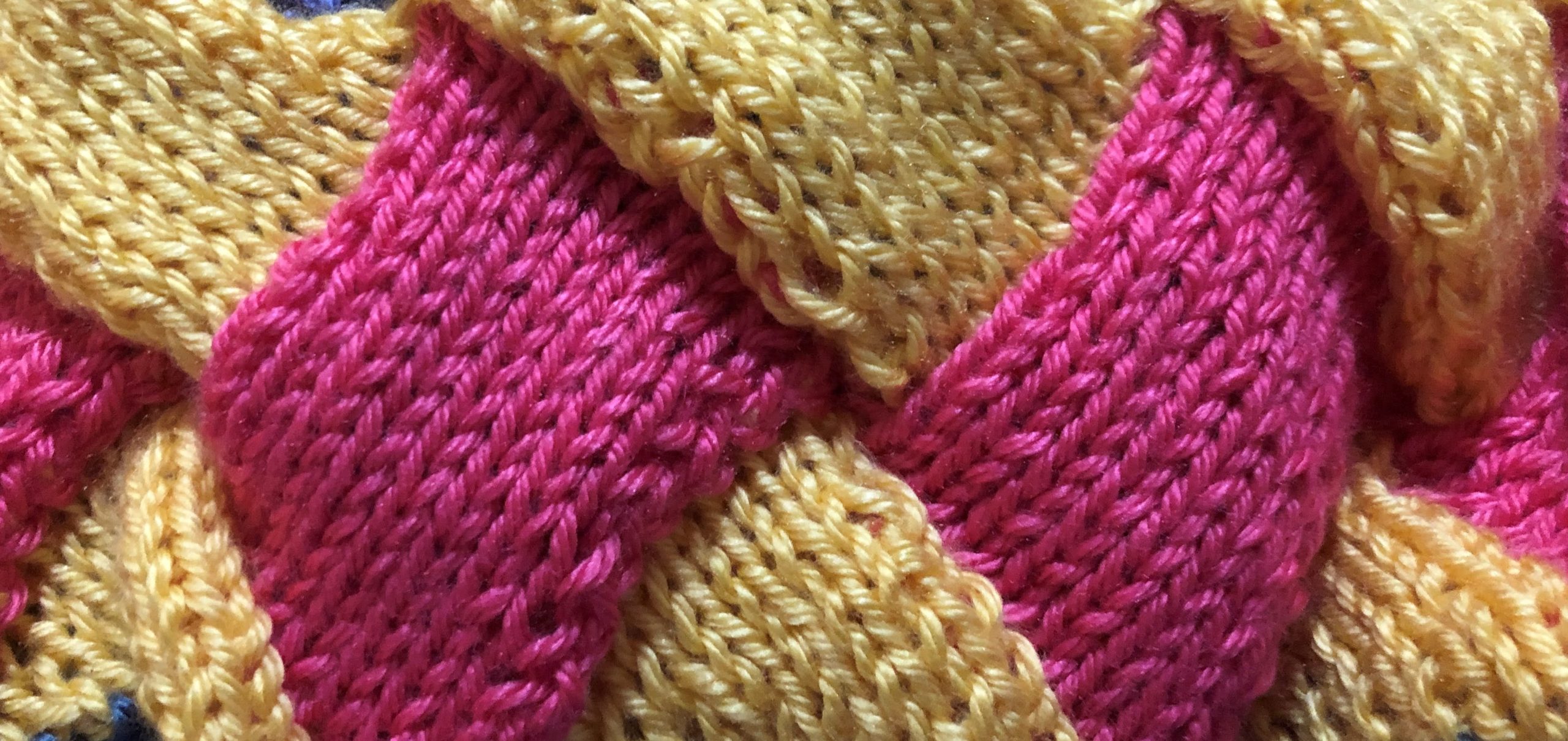
About Entrelac
The word entrelac comes from entrelacer, meaning interlocking lace. It’s a fitting name based on the look of the finished product.
Entrelac has a complicated look and the instructions can be daunting, but the construction is actually simple. It is worked in short rows. For this project, the multiple of stitches used in the short rows is 10. This means you’ll never be working with more than 10 stitches at a time!
Since you are working on such a large project, you might benefit from using double pointed needles for this section. You can work with 10 stitches at a time, then transfer them to your circular needles.
Construction
Entrelac is comprised of 4 parts, usually referred to as tiers.
Base Tier
Also called the Bottom Tier, this section consists of multiple identical isosceles triangles. The bottoms are flat (horizontal) and the left and right side of the triangle are the same length.
The Base Tier is worked from right to left across the project, as a RS row would be worked in traditional knitting.
First Tier
The First Tier of entrelac consists of one set of short rows worked as a left triangle, one or more sets worked as rectangles, and one set worked as a right triangle.
The First Tier (Triangle-Rectangle-Triangle) is worked from left to right, as a WS row would be worked in traditional knitting.
Second Tier
The Second Tier is an all-rectangle tier. It is worked from right to left, as a RS row would be worked in traditional knitting.
Final Tier
This tier, also called the Finishing Tier, is a mirror of the Base Triangles Tier. The horizontal side of the triangle is the top.
This Top Triangles Tier is worked from right to left, as a RS row would be worked in traditional knitting. Once complete, there are no stitches left to bind off!
Putting It All Together
A Base Tier and Finishing Tier are a must for any project. In-between those, an odd number of tiers must be worked.
For the small afghan, work:
Base Tier, Tier 1, Top Tier
For the large afghan, work:
Base Tier, Tier 1, Tier 2, Tier 1, Top Tier
Base Tier Triangles
The base triangles are identical triangles worked across the bottom of this section from right to left.
Turn your work after each row.
Color B:
Row 1 (RS) – k1
Row 2 – p1
Row 3 – sl1, k1
Row 4 – p2
Row 5 – sl1, k2
Row 6 – p3
Row 7 – sl1, k3
Row 8 – p4
Row 9 – sl1, k4
Row 10 – p5
Row 11 – sl1, k5
Row 12 – p6
Row 13 – sl1, k6
Row 14 – p7
Row 15 – sl1, k7
Row 16 – p8
Row 17 – sl1, k8
Row 18 – p9
Row 19 – sl1, k9, do not turn
Repeat these 19 rows till you reach the end of your work.
18 (24) base triangles completed.
Base Tier Video
Tier 1 (Triangle-Rectangles-Triangle)
Tier 1 is comprised of a left triangle, rectangles across the width of the afghan, and a right triangle. Tier 1 is used when working from the left side of the work to the right.
Tier 1 Left Triangle
The Left Triangle is comprised of the first 10 stitches on your needle. Make one.
Turn your work after each row.
Color C:
Row 1 (WS) – k1
Row 2 – kfb
Row 3 – k1, p2tog
Row 4 – k1, kfb
Row 5 – k1, p1, p2tog
Row 6 – k2, kfb
Row 7 – k1, p2, p2tog
Row 8 – k3, kfb
Row 9 – k1, p3, p2tog
Row 10 – k4, kfb
Row 11 – k1, p4, p2tog
Row 12 – k5, kfb
Row 13 – k1, p5, p2tog
Row 14 – k6, kfb
Row 15 – k1, p6, p2tog
Row 16 – k7, kfb
Row 17 – k1, p7, p2tog
Row 18 – k8, kfb
Row 19 – k1, p8, p2tog, do not turn
1 (1) triangle completed.
Tier 1 Left Triangle Video
Tier 1 Rectangles
Turn your work after each row.
Color C:
Row 1 (WS) – pick up and p9 along edge, p1 (first stitch of next section)
Row 2 – k10
Row 3 – sl1, p8, p2tog
Row 4 – k10
Row 5 – sl1, p8, p2tog
Row 6 -k10
Row 7 -sl1, p8, p2tog
Row 8 – k10
Row 9 – sl1, p8, p2tog
Row 10 -k10
Row 11 – sl1, p8, p2tog
Row 12 – k10
Row 13 – sl1, p8, p2tog
Row 14 – k10
Row 15 – sl1, p8, p2tog
Row 16 – k10
Row 17 – sl1, p8, p2tog
Row 18 – k10
Row 19 – sl1, p8, p2tog, do not turn
Repeat these 19 rows until one selvage edge remains.
16 (22) rectangles completed.
Tier 1 Rectangles Video
Tier 1 Right Triangle
Make one right triangle to complete this tier.
Turn your work after each row.
Color C:
Row 1 (WS) – pick up and p9 along edge
Row 2 – k9
Row 3 – sl1, p6, k2tog
Row 4 – k8
Row 5 – sl1, p5, k2tog
Row 6 – k7
Row 7 – sl1, p4, k2tog
Row 8 – k6
Row 9 – sl1, p3, k2tog
Row 10 – k5
Row 11 – sl1, p2, k2tog
Row 12 – k4
Row 13 – sl1, p1, k2tog
Row 14 – k3
Row 15 – sl1, k2tog
Row 16 – k2
Row 17 – k2tog, sl this st to LHN, turn
1 (1) triangle completed.
Tier 1 Right Triangle Video
Tier 2 (Rectangles)
Tier 2 is comprised of identical rectangles across the width of the afghan. Tier 2 is used when working from the right side of the work to the left.
Turn your work after each row.
The last stitch of Tier 1 is still on your needle and counts as the first stitch of your first rectangle and will count as one of the picked up stitches the first time you work row 1.
Color B:
Row 1 (RS) – 1 st on needle; pick up and k10 along edge, sl last st to LHN, ssk
Row 2 – p10
Row 3 – sl1, k8, ssk
Row 4 – p10
Row 5 – sl1, k8, ssk
Row 6 – p10
Row 7 – sl1, k8, ssk
Row 8 – p10
Row 9 – sl1, k8, ssk
Row 10 – p10
Row 11 – sl1, k8, ssk
Row 12 – p10
Row 13 – sl1, k8, ssk
Row 14 – p10
Row 15 – sl1, k8, ssk
Row 16 – p10
Row 17 – sl1, k8, ssk
Row 18 – p10
Row 19 -sl1, k8, ssk, do not turn
Repeat these 19 rows until you reach the end of your work.
18 (24) rectangles completed.
Tier 2 Rectangles Video
Repeat Tiers 1 and 2 if your work has not reached the desired length (3″/4″). End with Tier 1.
Final Tier (Triangles)
The final section is used after Tier 1 when the desired length has been reached. It is worked from left to right.
The last stitch of Tier 1 is still on your needle and counts as the first stitch of the first top triangle.
Each triangle worked will result in 1 stitch remaining. This stitch will count as the first stitch of the next triangle.
Color C:
Row 1 (RS) – 1 st on needle; pick up and k9 along edge, sl last st to LHN, ssk
Row 2 – p all
Row 3 – k2tog, k7, ssk
Row 4 – p all
Row 5 – k2tog, k6, ssk
Row 6 – p all
Row 7 – k2tog, k5, ssk
Row 8 – p all
Row 9 – k2tog, k4, ssk
Row 10 – p all
Row 11 – k2tog, k3, ssk
Row 12 – p all
Row 13 – k2tog, k2, ssk
Row 14 – p all
Row 15 – k2tog, k1, ssk
Row 16 – p all
Row 17 – k2tog, ssk
Row 18 – p all
Row 19 – sl1, ssk, psso, do not turn
One stitch remains.
Repeat rows 1-19 until you reach the end of the work.
For last triangle only, fasten off last st.
18 (24) triangles completed.
Final Tier Triangles Video
Finishing
Weave in your tails.
Examples
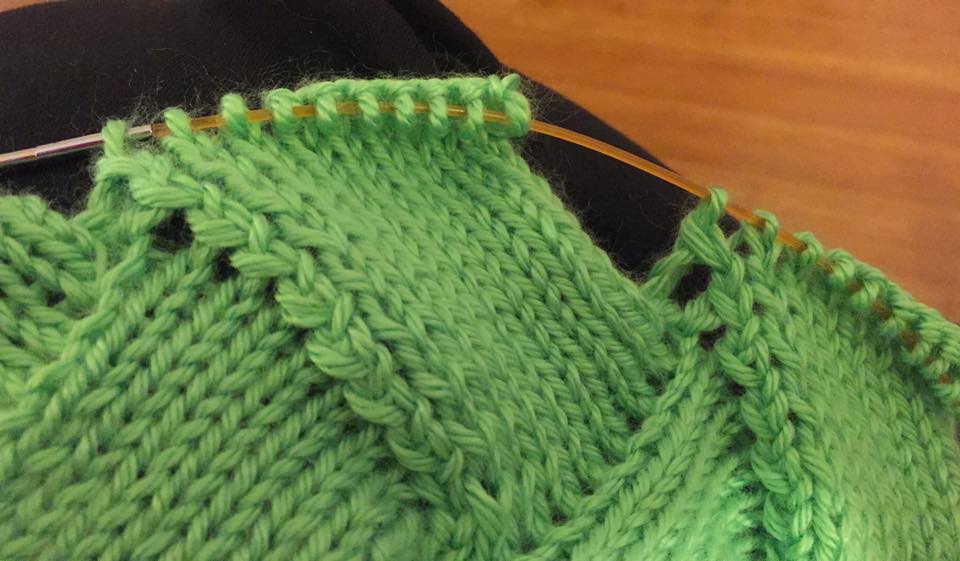
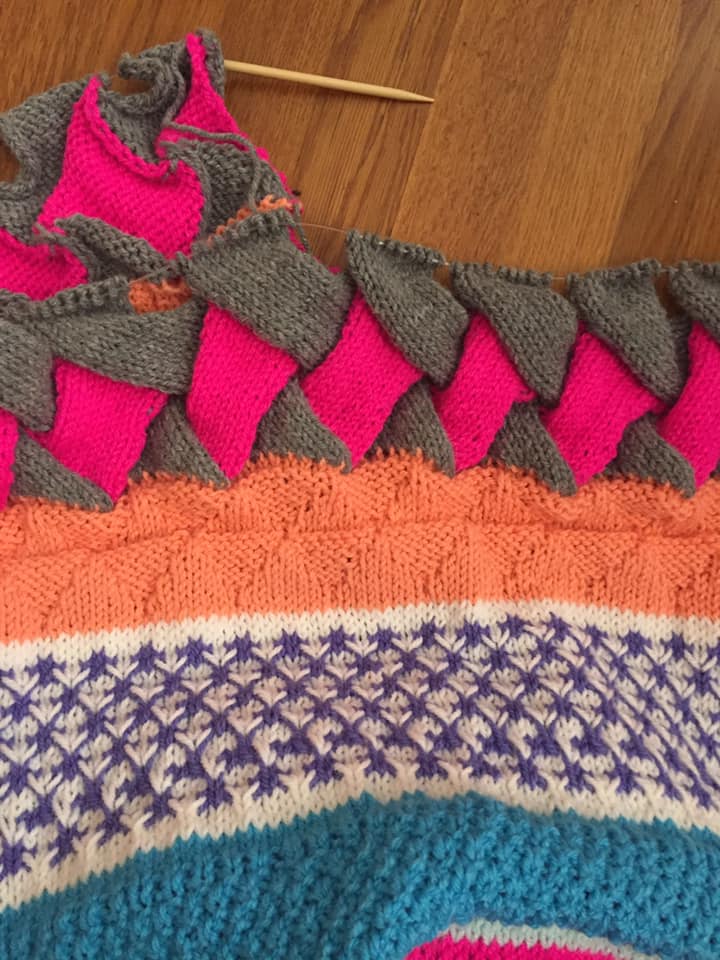
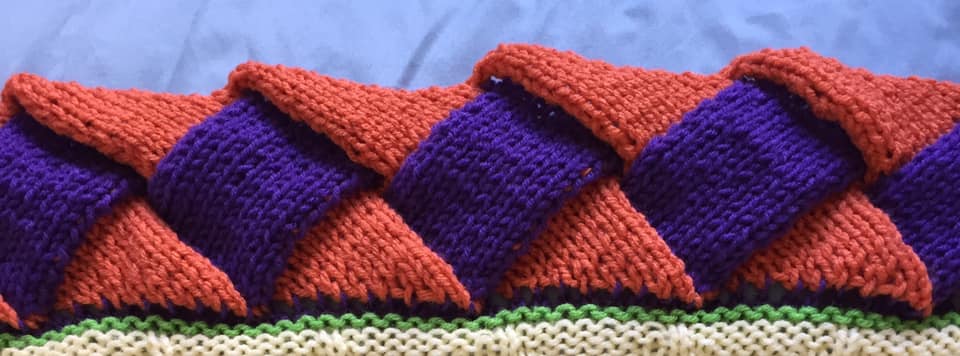
Need support? Want to share your progress? Join the Facebook group!
Come back next week for Part 13!



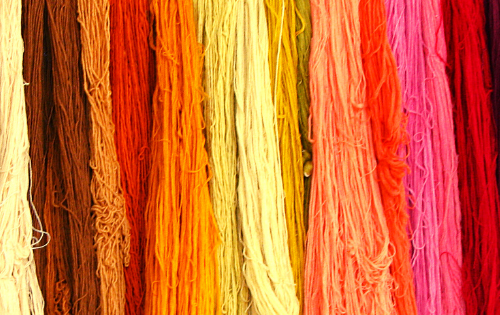
5 Comments
Pingback:
Pingback:
Andrew Caro
I love entrelac, especially because I use the KnitBackBackwards method, so don’t have to turn the work all the time. That saves a lot of time, and makes it less fussy. I’ve been kinda jonesing to get something going with entrelac, and you’ve added to the urge. Thanks!
Holly
Yes! I mention knitting backwards in one of the videos. I find myself looking it up and relearning it every time I do entrelac! It isn’t often enough for me to remember how to do it without help (or keep even tension without practice).
Do you always knit backwards on even rows or only with entrelac?
Andrew Caro
I do it most of the time, and learned how to do purling that way too. I love seed stitch, and recently learned broken rib, and do both without turning. Fortunately my tensioning is ok.